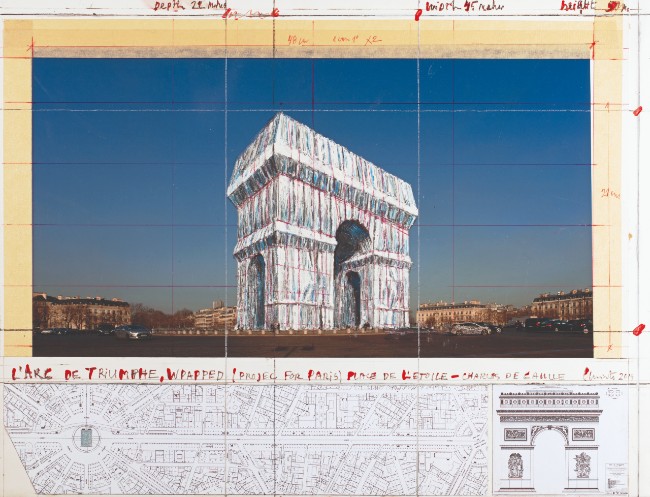What’s Hot in Paris for 2020
The City of Light is in a constant state of flux, says Jennifer Ladonne, with openings, refurbishments and one-off experiences offering culture vultures something new each time they pay a visit
When Ernest Hemingway described Paris as “a moveable feast”, he knew what he was talking about. A city which never stands still, each year brings a slew of blockbuster exhibitions, dazzling restaurants, inventive arts and irresistible boutiques. And 2020 is no exception. Come spring, as part of an ambitious project to turn Paris green, freshly-opened parks will be bursting into life, while autumn will herald the return of artist Christo, 35 years after he wrapped the Pont-Neuf in polyamide fabric, who this time has his sights set on the Arc de Triomphe. With so much going on, it’s impossible to cover everything but here’s our selection of the hot new attractions on offer in the City of Light.

The Liberation of Paris in 1944. Credit: Musée de la Libération de Paris
TRIUMPH AND RECKONING
The French Resistance was a small but mighty force during the Nazi occupation of Paris and a crucial source of morale for a population faced with constant privation and violence.
The new Musée de la Libération de Paris – Musée du général Leclerc – Musée Jean Moulin, which opened last August in time to mark the 75th anniversary of the Liberation of Paris, pays homage to two main heroes of the Resistance: Jean Moulin and Philippe Leclerc de Hauteclocque (aka Général Leclerc), alongside dozens of lesser-known characters whose wartime activities make for a gripping story.

The new Musée de la Libération de Paris – Musée du général Leclerc – Musée Jean Moulin
The museum is set in an elegant 18th-century pavilion atop a claustrophobic bunker, buried 65ft underground, which served as the Resistance high command from August 19-25, 1944. Energetic visitors can descend 100 vertiginous steps to the bunker, originally used as an air-raid shelter, to see how Colonel Rol-Tanguy and his staff received and relayed intelligence via the bunker’s private phone exchange – which linked important Resistance points, including police headquarters – to organise the final battles.

Follow the story of the Resistance ghters at the Musée de la Libération de Paris, where steep steps lead down to the bunker HQ
Visitors are led from the start of the occupation through to its dramatic finale via a series of themed rooms (with descriptions in English). You’ll find the museum across from the Catacombs, right next to the Denfert-Rochereau metro station.
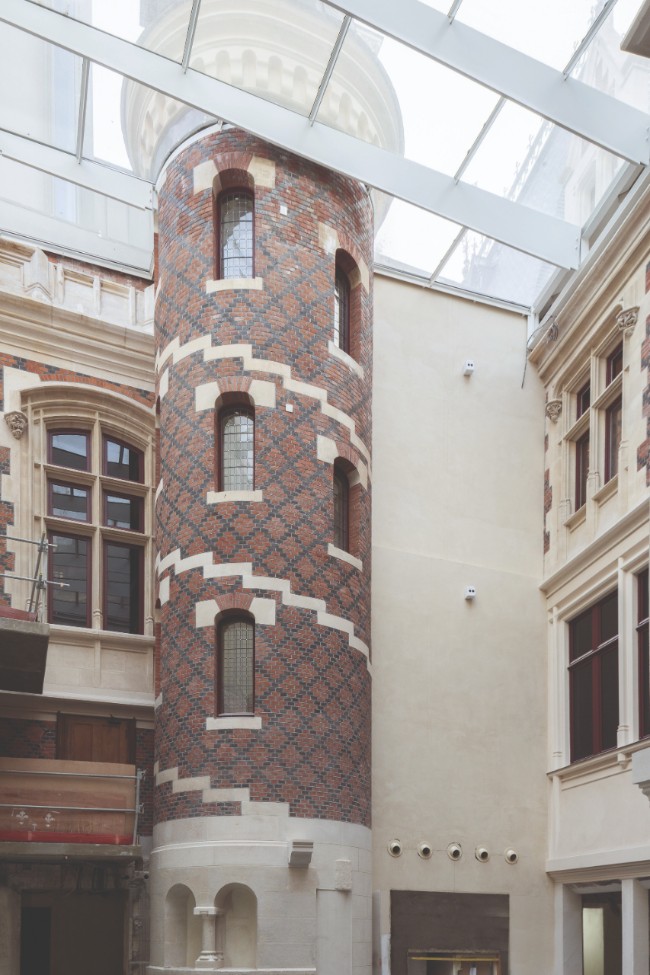
The Cité de l’Economie is a revelation. Photo: Charlotte Donker
IT’S ALL ABOUT THE MONEY
Only the Parisians could make economics sexy. The newly-refurbished Cité de l’Économie, known as Citéco, puts a fun, interactive spin on every aspect of the economy and finance. Subjects as far-flung as child investors and the resources that go into making a toaster are compelling for all ages. Rooms play on the contrast between the museum’s gorgeous 19th-century mansion setting and its state-of-the-art scenography, which uses video, films and slideshows, interactive games and animations to illuminate every facet of our global economy. The museum’s exhibits cover four floors and six sections, and address everything from markets and entrepreneurship to types of wealth and instability. There’s also a chic café and fascinating bookstore to boot.

The Cité de l’Économie has a surprisingly fun take on all things financial. Photo: Charlotte Donker
The splendid neo-Gothic mansion was, fittingly, home to a prominent 19th-century French banker, and then a branch of the Banque de France. Set in the elegant Parc Monceau neighbourhood that was pioneered by the great banking families – Rothschild, Camondo, Cernuschi and Ephrussi – it’s an excellent opportunity to visit the newly-refurbished Musée Nissim de Camondo and café and the Musée Cernuschi’s fascinating Asian treasures.

Cité de l’Economie’s Enterprise Tower. Photo: Charlotte Donker
VISIONARY NEW ART SPACE
Move over Centre Pompidou, Paris will soon be getting a new contemporary arts centre a stone’s throw both from Beaubourg and the Louvre. For years, French billionaire François Pinault, owner of the French luxury group Kering, among other holdings, sought an exhibition space in or around Paris to house his extensive private collection. Paris mayor Anne Hidalgo came to the rescue, offering Pinault the Bourse de Commerce, an iconic cylindrical building in Les Halles, for a 50-year, €15m lease.
Pinault called on Pritzker Prize-winning architect Tadao Ando to design and oversee the €150m project, which will convert the 130-year-old former grain and commodities exchange into a soaring contemporary space. Ando’s design will restore and preserve the historic monument’s exterior and interior façades, its 16th-century Medici column (erected in around 1574 by Catherine de’ Medici), two landmark spiral staircases, exquisite frescoes and glass dome.
A 30ft central internal cylinder will surround three floors of light-flooded exhibition space, a subterranean theatre, an upper viewing promenade and a top-floor restaurant – La Halle aux Grains – helmed by Michelin-starred chef Michel Bras, with views over Les Halles and nearby Saint-Eustache church.
The Bourse is Pinault’s third contemporary arts venue; the other two, also designed by Ando, being in Venice. The Paris gallery is intended, says Pinault, “to share my passion for contemporary art with as broad an audience as possible”. La Bourse de Commerce – Pinault Collection is scheduled to open in June.
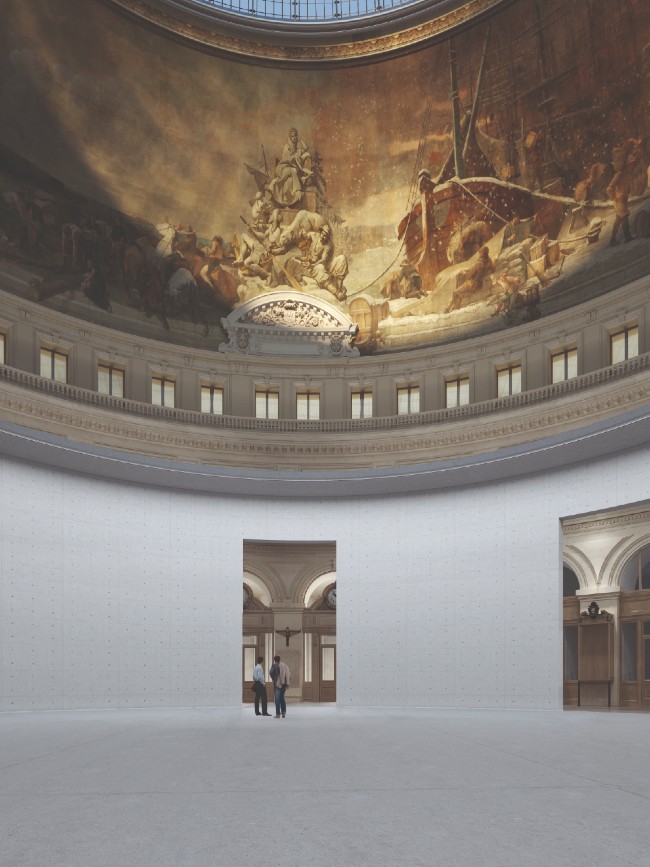
La Bourse de Commerce is all set to house works of art owned by collector François Pinault. Credit: EMILIE CHAIX
BELOVED LANDMARK REOPENS
Recently reopened following two and a half years of restoration work, the Théâtre du Châtelet’s 2020 season promises to take a new direction under the helm of co-directors Thomas Lauriot dit Prévost and Ruth Mackenzie, lately of the Scottish Opera and the Nottingham Playhouse.
The venue is set to stage a programme of more innovative productions by a lively roster of French and international artists, including a musical version of Albert Camus’s Les Justes, directed by the rapper Abd Al Malik, and a restaging of the late choreographer Pina Bausch’s The Seven Deadly Sins.
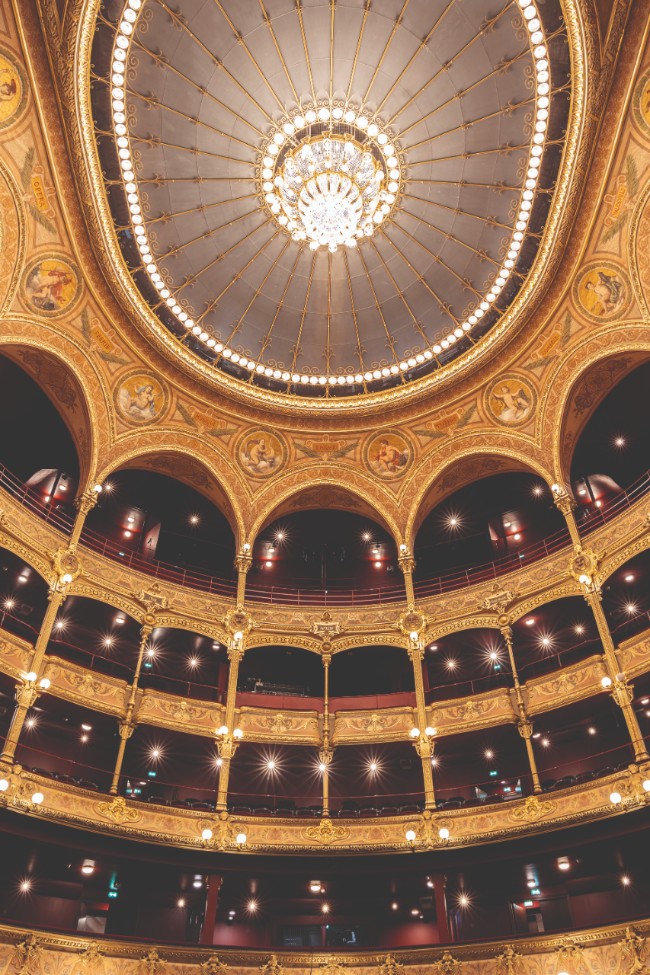
The Théâtre du Châtelet has been lovingly restored. Photo: Thomas Amouroux
This beloved Haussmannian landmark – which originally opened its doors in 1862 as part of Baron Haussmann’s “great transformation” – sits at the very heart of Paris, across from the Seine with a view to the Île de la Cité and Notre-Dame. Over its 157 years, Châtelet has welcomed a roster of great names – ballet dancers Anna Pavlova, Nijinsky and Diaghilev’s Ballets Russes, composers Erik Satie, Mahler, Strauss and Tchaikovsky, along with 20th-century masters Josephine Baker, Cole Porter and Juliette Gréco.
Already one of the most splendid theatres in Paris, Châtelet’s spruced-up interiors – courtesy of a €32.3m spending spree – are now positively gleaming, its crimson velvet seats lovingly reupholstered and its magnificent gilded interiors given a dazzling makeover.

The Louvre hosted a special Leonardo da Vinci retrospective. Photo: Shutterstock
LEONARDO AT THE LOUVRE
The city’s most highly-anticipated blockbuster, the exhibition ‘Leonardo da Vinci’ was at the Louvre until February 24, marking the 500th anniversary of the artist’s death. Nearing the end of his life, Leonardo moved to France at the invitation of François I, a keen fan of the Italian Renaissance painters. Bringing his unfinished Mona Lisa with him, he set up home at the Clos Lucé, near the king’s Loire residence of Château d’Amboise. Mona Lisa went on to become the star of François’s collection at the Château de Fontainebleau, until Louis XIV moved it to Versailles. It has been on display at the Louvre since 1797 (except for the brief period of time Napoleon squirrelled it away in his dressing room).

Leonardo da Vinci’s “La belle ferronnière” (Portrait of an Unknown Woman) hangs in the Louvre. Credit © Musée du Louvre, dist. RMN – Grand Palais Angèle Dequier
The Louvre retrospective assembled 10 of the master’s paintings, five of which are from the Louvre collection, including the exquisite The Virgin of the Rocks, Saint John the Baptist, and, of course, Mona Lisa. The exhibition included 162 drawings, sculptures and manuscripts– a rare perspective on one of the world’s greatest artists.
What you won’t be seeing is Salvator Mundi, the world’s most expensive painting, which sold at Christie’s in New York for $450.3m in November 2017. However, rumours continue to abound in the art world that it may still manage a late appearance at the Louvre. Watch this space…
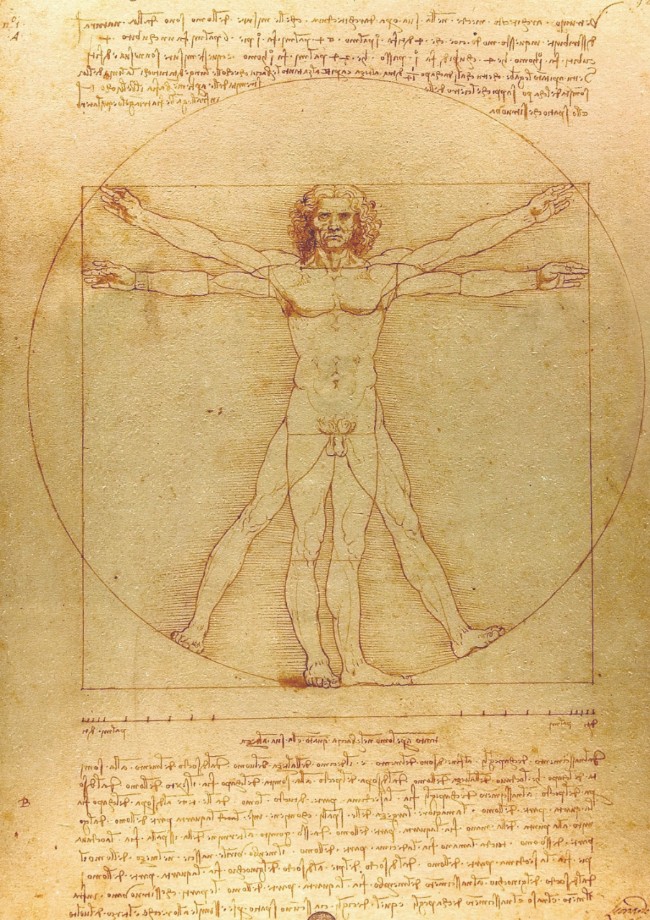
Leonardo da Vinci’s “Vitruvian Man” shows the artist’s talent for backwards writing. Credit: The Louvre
PARIS, ALL WRAPPED UP
On September 22, 1985, Christo and his late wife and collaborator, Jeanne-Claude, electrified Paris with their most startling project to date: the Pont-Neuf, the city’s oldest bridge, fully wrapped in 41,800 shimmering square metres of woven polyamide fabric.
This September, Christo will unveil a new, even more ambitious project – the wrapping of the Arc de Triomphe. The project, in collaboration with the Centre des Monuments Nationaux and the Centre Pompidou and fully funded by the artist, was originally scheduled for April 2020 but had to be postponed to avoid disturbing nesting falcons.
Now set to run for 16 days from September 19 to October 4, it brings to fruit a 60-year old idea hatched by Christo and Jeanne-Claude back in 1962.
‘L’Arc de Triomphe, Wrapped (Project for Paris, Place de l’Étoile – Charles de Gaulle)’ will see the famous landmark wrapped in 25,000 square metres of recyclable polypropylene fabric in silvery blue, and 7,000 metres of red rope.
“Do you know that I don’t have any artworks that exist? They all go away when they’re finished,” mused Christo. Better not miss this once-in-a-lifetime opportunity then. It is, after all, a chance to see Paris as you’ve never seen it before.
[Editor’s note: Keep in mind that because of the coronavirus pandemic, it’s important to check museum and event openings, many of which have been postponed.]
From France Today magazine
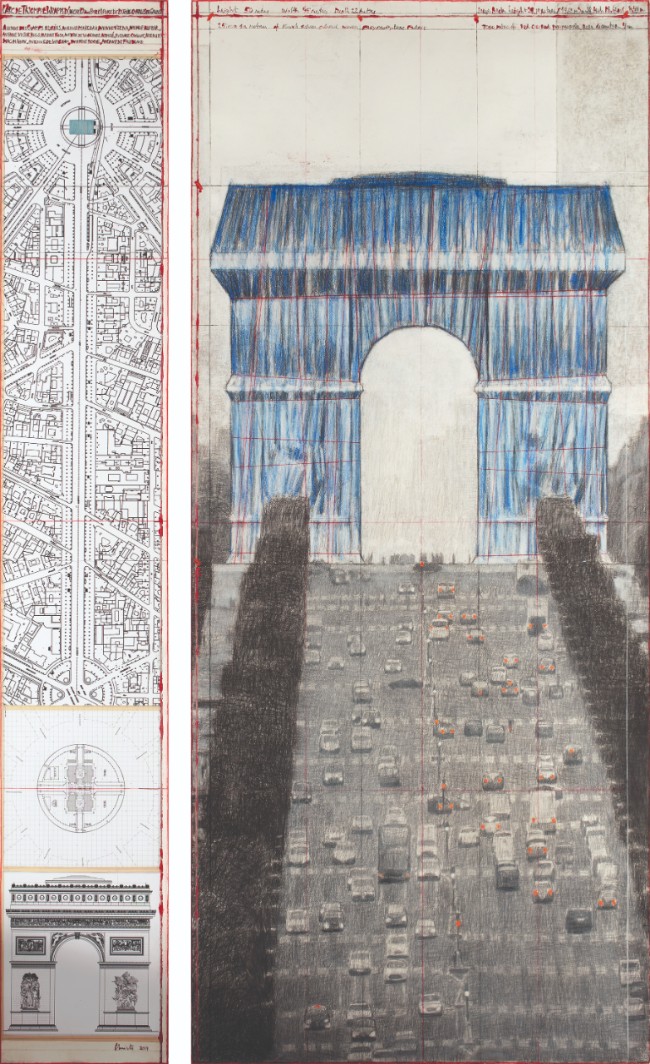
Christo’s sketches for ’L’Arc de Triomphe Wrapped’. Image: CHRISTO & JEANNE-CLAUDE
Share to: Facebook Twitter LinkedIn Email
Leave a reply
Your email address will not be published. Required fields are marked *

